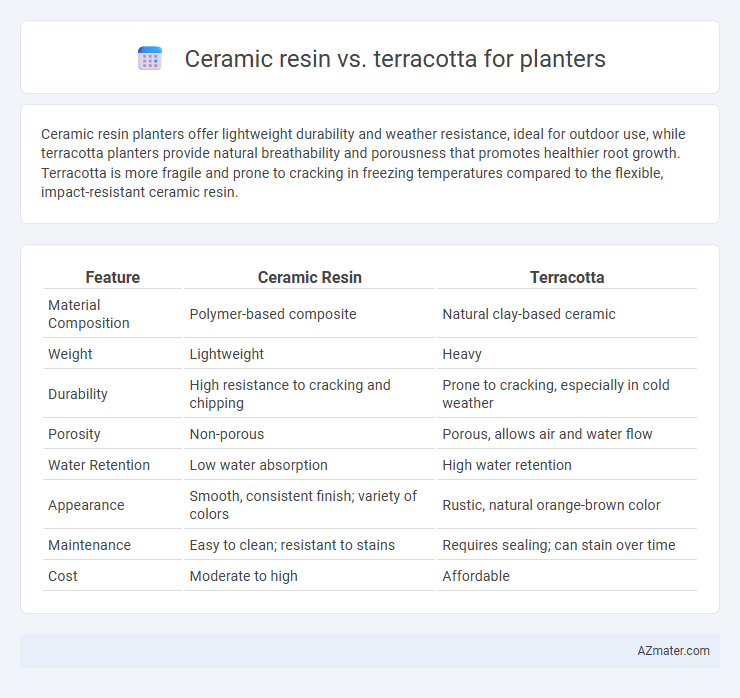Ceramic resin planters offer lightweight durability and weather resistance, ideal for outdoor use, while terracotta planters provide natural breathability and porousness that promotes healthier root growth. Terracotta is more fragile and prone to cracking in freezing temperatures compared to the flexible, impact-resistant ceramic resin.
Table of Comparison
| Feature | Ceramic Resin | Terracotta |
|---|---|---|
| Material Composition | Polymer-based composite | Natural clay-based ceramic |
| Weight | Lightweight | Heavy |
| Durability | High resistance to cracking and chipping | Prone to cracking, especially in cold weather |
| Porosity | Non-porous | Porous, allows air and water flow |
| Water Retention | Low water absorption | High water retention |
| Appearance | Smooth, consistent finish; variety of colors | Rustic, natural orange-brown color |
| Maintenance | Easy to clean; resistant to stains | Requires sealing; can stain over time |
| Cost | Moderate to high | Affordable |
Introduction to Planter Materials: Ceramic Resin vs Terracotta
Ceramic resin planters offer lightweight durability and resistance to cracking, making them ideal for various indoor and outdoor environments. Terracotta planters, made from natural clay, provide excellent breathability and water drainage, promoting healthy root growth but tend to be heavier and more fragile. Choosing between ceramic resin and terracotta depends on balancing aesthetics, weight, and maintenance needs for optimal plant health.
Composition and Manufacturing Differences
Ceramic resin planters are composed of a mixture of resin and ceramic particles, resulting in a lightweight, durable, and weather-resistant material ideal for outdoor use. Terracotta planters consist of natural clay fired at high temperatures, producing a porous, breathable material that helps regulate soil moisture but is more fragile and heavier. The manufacturing process for ceramic resin involves molding and curing synthetic materials, whereas terracotta planters are shaped by hand or wheel and kiln-fired, influencing their texture, durability, and moisture retention properties.
Aesthetic Appeal: Color, Texture, and Finish
Ceramic resin planters offer a sleek, modern aesthetic with smooth finishes and vibrant color options that resist fading, enhancing garden design with consistent hues. Terracotta planters bring a classic, earthy texture and warm, natural tones that develop a unique patina over time, adding character and organic charm. The matte, porous surface of terracotta contrasts with the glossy, non-porous finish of ceramic resin, influencing both visual appeal and the planter's interaction with surrounding elements.
Durability and Weather Resistance
Ceramic resin planters offer superior durability and weather resistance compared to traditional terracotta due to their lightweight, non-porous composition that prevents cracking and fading in extreme temperatures. Terracotta planters, while breathable and natural, are prone to chipping, cracking, and water absorption, which can lead to damage during freeze-thaw cycles. For long-lasting outdoor use, ceramic resin's resistance to UV rays, moisture, and temperature fluctuations makes it a more practical choice.
Weight and Handling Considerations
Ceramic resin planters are notably lighter than terracotta, making them easier to move and handle, especially for larger pots or frequent repositioning on patios and indoors. Terracotta planters, while heavier and more fragile, provide natural breathability for roots but require careful handling to prevent chipping or breaking during transport. The weight difference significantly impacts ease of installation and long-term maintenance, with ceramic resin offering superior durability and portability.
Breathability and Plant Health
Ceramic resin planters provide better breathability compared to terracotta, allowing air and moisture to circulate more efficiently around plant roots, which reduces the risk of root rot and promotes healthier growth. Terracotta, while porous, tends to dry out quickly, requiring more frequent watering but enhancing soil aeration through its natural permeability. The choice between ceramic resin and terracotta impacts plant health by balancing moisture retention and air exchange critical for root respiration and overall vitality.
Drainage Capabilities
Ceramic resin planters typically incorporate built-in drainage holes or elevated bases, allowing excess water to escape and preventing root rot, making them ideal for moisture-sensitive plants. Terracotta planters are naturally porous, facilitating air exchange and gradual water evaporation through their walls, which improves drainage but requires more frequent watering. Choosing between ceramic resin and terracotta depends on plant water needs and desired maintenance frequency, with terracotta offering superior breathability and ceramic resin providing controlled drainage.
Cost Comparison: Investment and Longevity
Ceramic resin planters typically offer a lower upfront investment compared to terracotta, making them a cost-effective choice for budget-conscious buyers. While terracotta planters generally have a higher initial cost, their natural porosity and durability contribute to long-term benefits by promoting healthier root systems and reducing the need for frequent replacement. Over time, the longevity of terracotta planters often justifies the higher investment through sustained strength and aesthetic appeal, whereas ceramic resin may require more frequent replacement despite its affordability.
Eco-Friendliness and Sustainability
Ceramic resin planters offer durability and lightweight benefits but often contain synthetic materials and non-biodegradable resins, impacting their eco-friendliness negatively compared to terracotta. Terracotta planters are made from natural clay, allowing them to biodegrade and recycle naturally, making them a more sustainable and environmentally friendly option. Their porous nature also promotes better root health and reduces the need for chemical interventions, supporting greener gardening practices.
Best Applications: Choosing the Right Planter for Your Needs
Ceramic resin planters offer lightweight durability and sleek finishes, ideal for indoor plants and contemporary decor, while terracotta planters provide porous, breathable properties that promote healthy root systems, best suited for outdoor use and drought-tolerant plants. Ceramic resin resists cracking and fading in extreme weather, making it perfect for patios or balconies, whereas terracotta is better for Mediterranean or rustic garden settings where moisture regulation is critical. Selecting between ceramic resin and terracotta depends on your planting environment, desired aesthetic, and maintenance preferences to ensure optimal plant growth and planter longevity.

Infographic: Ceramic resin vs Terracotta for Planter
 azmater.com
azmater.com